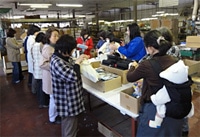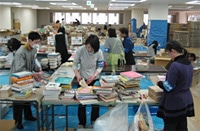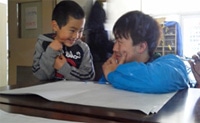



[TOKYO, Japan, 21 April 2011]
Today many schools in the disaster area held opening ceremonies. The Japan Committee for UNICEF (JCU) has continued to extend assistance for the reopening of schools, providing stationery, various school supplies needed by teachers and other goods. JCU has also provided children with psychological assistance via the implementation of Child Friendly Spaces in many areas following the earthquake. A large number of volunteers have been working on the frontline to carry out these activities.
 |
| © Japan Committee for UNICEF |
| Volunteers from Hiroshima, Okayama, Kagawa and Ehime Prefectures packaging stationery. |
In Okayama Prefecture, volunteers worked to package stationery sets for approximately 16,000 primary and junior high school students living in Iwate Prefecture. A total of 105 volunteers from JCU chapters in Okayama, Hiroshima, Kagawa and Ehime came to help prepare the sets. JCU Okayama staff member Masako Kataoka said, “There was a mother that worked these two days with her baby on her back. The baby was only five months old, and she would sleep and cry while on her mother’s back. I am sure that baby is happy to have a mom like that.”
“Everyone is thankful to have been able to participate in this work and make a contribution, even if only a small one. They have told me things like, ‘While working I thought about the children that are going to be happy to receive the stationery as well as the children that had died in the disaster, and it made me feel sad.’ ‘I was extremely happy to be able to do something for the children, even if only for a short time. I believe that the harder the circumstances, the easier it is to relate and share the pain and sorrow with others,’” said Ms. Kataoka.
 |
| © Japan Committee for UNICEF |
The donations of picture books, kami shibai (Japanese picture card stories) and children’s books made to the UNICEF Children’s Mini Library greatly exceed initial expectations in number, and a large number of volunteers from Tokyo and Kanagawa Prefecture have been working everyday to separate, package and ship them.
Picture on right: Volunteers from JCU Kanagawa separating, packaging and shipping children’s books for the UNICEF Children’s Mini Library project.
 |
| © Japan Committee for UNICEF |
| Children and volunteers playing at a Child Friendly Space at a shelter in Ishinomaki City, Miyagi Prefecture. |
Meanwhile, nearly 40 university students from different prefectures joined hands as volunteers at disaster sites in Iwate and Miyagi Prefectures to provide psychological assistance to children via Child Friendly Spaces under the direction of Japanese experts dispatched from UNICEF. Child Friendly Spaces are being promoted using Early Childhood Development (ECD) Kits and recreation kits delivered from the UNICEF Supply Division in Copenhagen after adding clay, origami paper and other toys that Japanese children are familiar with, and making other creative changes to ensure that the spaces are a place that is fun for children.
Ms. Saito, a senior in college that volunteered in Miyagi prefecture, commented that, “I was so happy to get to know these children. During picture time there was one child that drew a picture of a tsunami, and it left me with mixed emotions.” Koki Otaka, a freshman in college, said, “I always wanted to do something for the disaster area. I was surprised and relieved to see how energetic the kids were. I am very grateful for the opportunity to take part in this type of effort.” Also, Wataru Sasaki, a student from Morioka Junior College that participated in the activities, said, “I became impatient watching the scenes of the disaster area on television and decided to join the effort myself. The work was hard but I it motivated me knowing that what I was doing would make life easier for the primary school students. My younger brother is also in primary school, so it makes me happy to help out other children that are his age, even if only a little.”
JCU staff member Yukiko Asami has been involved in Child Friendly Space activities at a shelter in Ishinomaki City. Ms. Asami said that it took more than three weeks after the disaster, but children finally began speaking more about it. “One boy, a first year junior high school student that was on the way home from school when he heard the tsunami alarm and was able to escape back to school, told me, ‘They still haven’t found some of my classmates yet. I will start junior high school in April, but even the school uniform I bought is dirty.’ His mother also said that she is scared everyday when she returns home, which is surrounded by rubble, because of the thought that she may find a dead body. The children really look forward to UNICEF coming. On the outside these children appear no different than any ordinary child; however, there were times when you could sense the presence of sadness or discomfort in their behaviour or expressions, such as when begging for a piggy-back ride or hug, crying over something small, becoming aggressive, and asking everyday ‘Are you coming back tomorrow, too?’”
 |
| © Japan Committee for UNICEF |
Soichiro Kurotaki, a Meiji Gakuin University student that joined activities in Miyagi Prefecture, said that, “I participated in activities related to Child Friendly Spaces for 10 days. During that short time I experienced things that I normally wouldn’t have been able to experience in over a year. At the disaster area there were people that had lost everything yet still had a strong will to live. Meeting these people made me realize that I have to keep strong.”
Picture on right: Haruto Suzuki, a child staying at a shelter set up at Higashihama Primary School in Ishinomaki City, tells Ryuichiro Kurotaki(Meiji Gakuin University) about his experience: “When the earthquake happened on 11 March I came to the gym. Then I heard the roof make this loud boom sound. The glass from the windows began to break and the clock and other things started to fall down. We all cleaned up everything, but the glass broke again because of an aftershock on 7 April, so we had to clean it up once again.”
| Receiving Prefecture |
Type of Emergency Supplies |
Arrival Date |
Quantity | Donating Company |
Comments |
|---|---|---|---|---|---|
| Miyagi | Water | 19 Mar. | 12,288 bottles |
VanaH Co., Ltd. | Two-liter plastic bottles |
| Fukushima | Water | 22 Mar. | 12,672 bottles |
VanaH Co., Ltd. | Two-liter plastic bottles |
| Miyagi | Underwear for boys and girls | 22 Mar. | 200,000 | ||
| Iwate | Underwear for boys and girls | 23 Mar. | 30,000 | ||
| Fukushima | Water | 23 Mar. | 4,680 bottles |
KIRIN MC DANONE WATERS Co., Ltd. | Two-liter plastic bottles |
| Miyagi | Children’s shoes | 23 Mar. | 10,000 pairs |
||
| Miyagi | RChildren’s diapers | 24 Mar. | 80 packs | P&G Japan | |
| Iwate | Children’s underwear | 24 Mar. | 9,700 | ||
| Fukushima | Water | 24 Mar. | 12,288 bottles |
VanaH Co., Ltd. | Two-liter plastic bottles |
| Iwate | Shoes | 26 Mar | 1,404 pairs | Achilles Corporation | |
| Iwate | Underwear for boys and girls | 27 Mar. | 28,266 | ||
| Iwate | Boots | 27 Mar. | 7,462 pairs | ||
| Iwate | Wipes | 28 Mar. | 1,200 | P&G Japan | For babies |
| Miyagi | Recreation kits Early Childhood Development kits |
2 Apr. | 50 of each | Procured from the UNICEF Supply Division | |
| Iwate | Recreation kits Early Childhood Development kits |
2 Apr. | 50 of each | Procured from the UNICEF Supply Division | |
| Miyagi | Book bags | 6 Apr. | 70 | Nihon New Bag Chain | |
| Iwate | Book bags | 6 Apr. | 340 | Seiban | |
| Miyagi | Schoolbags | 8 Apr. | 18,000 | Procured from the UNICEF Supply Division | |
| Iwate | Schoolbags | 8 Apr. | 18,000 | Procured from the UNICEF Supply Division | |
| Miyagi | Personal security buzzers (for crime prevention purposes) | 8 Apr. | 5,000 | ||
| Iwate | Personal security buzzers (for crime prevention purposes) | 8 Apr. | 5,000 | ||
| Fukushima | Water | 11 Apr. | 1,536 bottles | VanaH Co., Ltd. | Two-liter plastic bottles |
| Miyagi | Replenishments for recreation kits | 12 Apr. | 60 sets | ||
| Miyagi | Miniature toy cars | 12 Apr. | Approx. 1,200 | TAKARA TOMY | |
| Sagamihara* | Water | 12 Apr. | 12,288 bottles | VanaH Co., Ltd. | Two-liter plastic bottles |
| Miyagi | Play mats | 13 Apr. | Two types; 80 of each type | IKEA | |
| Miyagi | Drawing sets | 13 Apr. | 60 sets | IKEA | |
| Iwate | Chairs (for 3-5 year olds) | 14 Apr. | 75 | ||
| Iwate | Tables (for 6 people) | 14 Apr. | 11 | ||
| Iwate | Low tables | 14 Apr. | 9 | ||
| Iwate | Notebooks and stationery sets for primary and junior high school students | 15. Apr. | 16,700 sets | ||
| Miyagi | 183 computers | 18-21 Apr. | 3 computers at 61 locations | Distributed to kindergartens, primary, junior high and high schools affected by the disaster as well as their new locations | |
| Miyagi | Copier/fax machines | 18-21 Apr. | 57 | Distributed to kindergartens, primary, junior high and high schools affected by the disaster as well as their new locations | |
| Miyagi | Printers | 18-21 Apr. | 61 | Distributed to kindergartens, primary, junior high and high schools affected by the disaster as well as their new locations |
*Areas receiving disaster victims.
*In certain cases some supplies may be taken from prefectural supply storage warehouses and distributed to shelters and disaster sites in other prefectures.
As of 9:00 a.m. on 20 April 2011 (compiled by the Information and Public Affairs Division).